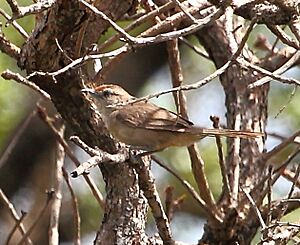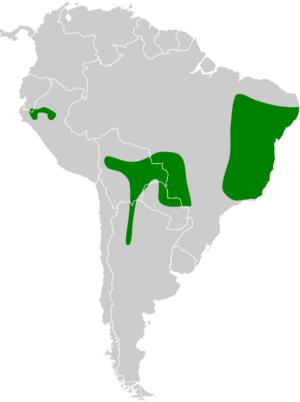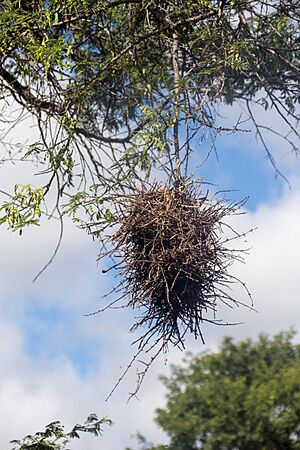Rufous-fronted thornbird facts for kids
Quick facts for kids Rufous-fronted thornbird |
|
|---|---|
 |
|
| at Serra da Canastra National Park, Minas Gerais state, Brazil. | |
| Conservation status | |
| Scientific classification | |
| Genus: |
Phacellodomus
|
| Species: |
rufifrons
|
 |
|
The rufous-fronted thornbird, also known as the common thornbird, is a type of bird found in South America. Its scientific name is Phacellodomus rufifrons. These birds live in several countries, including Brazil, Bolivia, Argentina, Ecuador, Paraguay, and Peru. They are part of the Furnariidae family, which includes many birds that build unique nests.
Contents
About the Rufous-fronted Thornbird
What Does the Rufous-fronted Thornbird Look Like?
The rufous-fronted thornbird is a medium-sized bird, about 16 to 17 centimeters (6.3 to 6.7 inches) long. It weighs between 18 and 31 grams (0.6 to 1.1 ounces), which is about the same as a few quarters. Both male and female birds look alike.
They have a pale, dull buff stripe above their eye, which continues past it. A dark brown stripe runs behind the eye. Their face is mostly pale buff-brown, with dark grayish skin around their eyes (called lores). The front part of their head (forehead) is a dark reddish-brown color, which is where they get the "rufous-fronted" part of their name. The top of their head is dark brownish with some lighter streaks.
Their upper body is a slightly lighter dark brown. Their wings are mostly dull brown, and their tail is also dull brown. The underside of their body is mostly brownish-white, with darker brownish sides and a pale reddish-brown color under their tail. Their eyes can be brown or grayish-white. Their beak is dark gray to blackish on the top part (maxilla) and gray to blue-gray on the bottom part (mandible). Their legs and feet are gray.
Young thornbirds look a bit different. They don't have the reddish-brown forehead, and their underparts have a mottled, patchy look.
Where Does the Rufous-fronted Thornbird Live?
The rufous-fronted thornbird lives in different areas that are not connected, across South America. You can find them in places like:
- Northern Peru and Southern Ecuador: In the upper parts of the Marañón River.
- Northeastern Brazil: In the state of Pernambuco.
- Eastern Brazil: From Maranhão south to São Paulo state.
- Eastern Bolivia, Central Brazil, Paraguay, and Northwestern Argentina: As far south as Tucumán Province.
These birds like to live in various environments, but they all have one thing in common: dense bushes and some trees. They can be found in dry scrublands, tropical forests (both wet and dry), and grassy areas called cerrado or savannah. In Brazil, they usually live below 1,300 meters (4,300 feet) in elevation. In other areas, they can be found as high as 2,000 meters (6,600 feet).
Thornbird Behavior
Movement and Daily Life
The rufous-fronted thornbird is a resident bird. This means it stays in the same area all year round and does not migrate to different places.
What Do Thornbirds Eat?
These birds mostly eat arthropods, which include insects and spiders. They usually look for food in pairs or small groups. Sometimes, other birds, like their own young from previous years, might join them to help. They mostly search for food on the ground, picking up prey from fallen leaves. However, they can also look for food in dead leaves on bushes, up to the middle level of a forest.
Reproduction and Life Cycle
The rufous-fronted thornbird breeds during the spring and summer in the Southern Hemisphere, usually from September to April. They are thought to be monogamous, meaning a pair stays together all year. Young birds from earlier broods sometimes stay with their parents. These helpers can assist with building and maintaining the nest, and even defending it.

These birds build very large nests for their size. The nest is like a long cylinder made of sticks, including thorny ones, and can be up to 2.5 meters (8 feet) long! It has several rooms and entrances. Often, a pair will build more than one nest in their territory. They might also fix up and reuse old nests. A female thornbird usually lays two to four eggs. Scientists don't yet know how long it takes for the eggs to hatch or for the young birds to leave the nest. Both parents, and any helpers, bring food to the baby birds.
How Do Thornbirds Communicate?
The rufous-fronted thornbird's song is a series of high-pitched, "mewing" notes that go up and down. Their calls include a very high, sharp "sipsipsip-sip-" sound, or a sharp "chip," "chek," or metallic "tsi."
Thornbird Status
The IUCN (International Union for Conservation of Nature) has listed the rufous-fronted thornbird as a species of "Least Concern." This means they are not currently in danger of disappearing. They live across a very large area, even though it's spread out. Their total population size isn't known, but it's believed to be stable. There are no immediate threats to this bird. It's considered fairly common in most places where it lives and is found in many protected areas. It can also handle some changes to its habitat caused by humans.


